Management Accounting: Costs and Decision Making Analysis
VerifiedAdded on 2021/04/17
|7
|1437
|96
Report
AI Summary
This report delves into the realm of management accounting, providing a detailed analysis of various cost classifications and their relevance in organizational decision-making. The report begins with an introduction to the subject, followed by a discussion of several cost types, including fixed and variable costs, direct and indirect costs, product and period costs, opportunity costs, differential costs, and sunk costs. Each cost type is defined and explained in terms of its behavior and nature. The core of the report examines the relevance of each cost type in the decision-making process of an organization, highlighting how these costs influence pricing, resource allocation, production planning, and overall business strategy. The report concludes by summarizing the key findings, emphasizing the importance of cost analysis in optimizing production levels, improving efficiency, and maximizing profitability. The references include several academic sources that support the analysis.
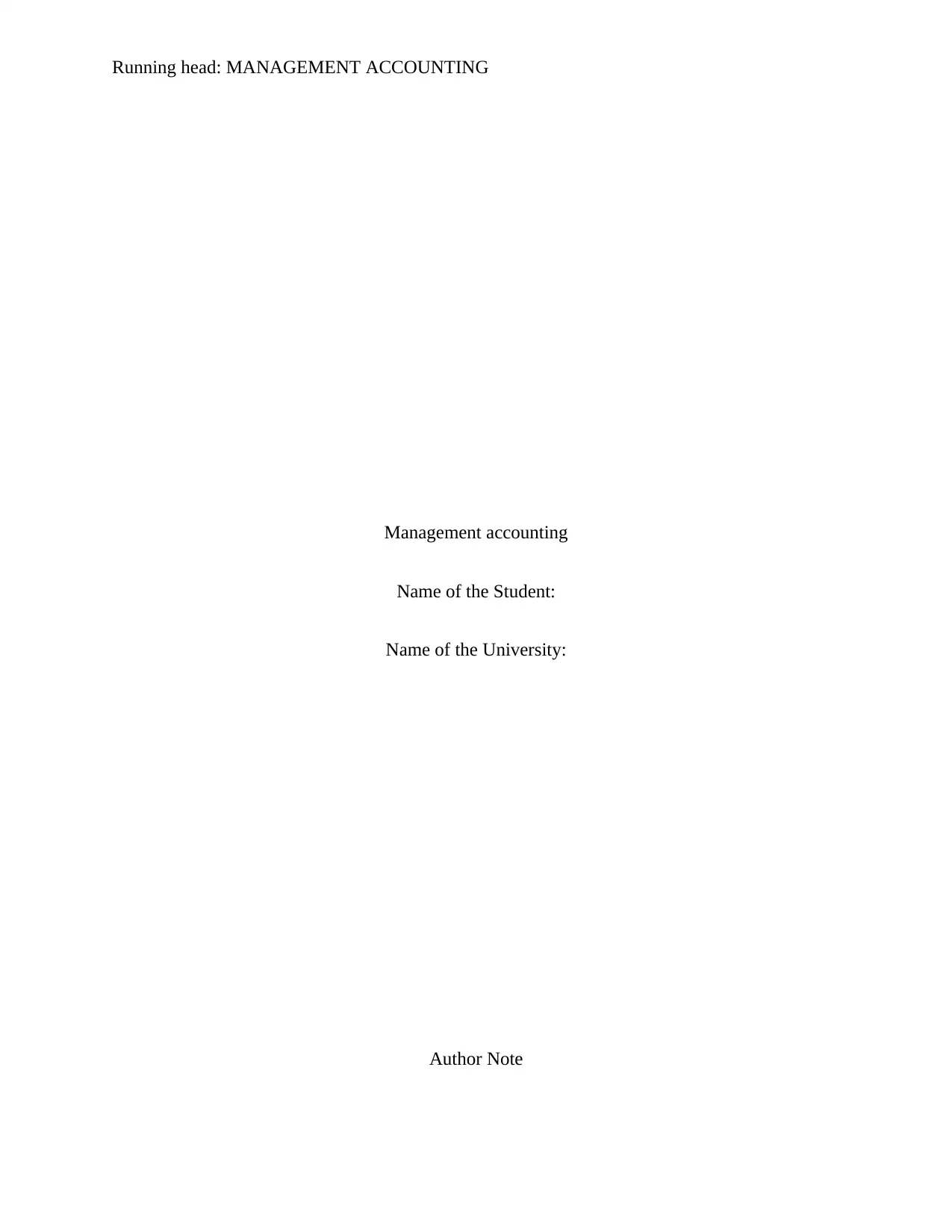
Running head: MANAGEMENT ACCOUNTING
Management accounting
Name of the Student:
Name of the University:
Author Note
Management accounting
Name of the Student:
Name of the University:
Author Note
Paraphrase This Document
Need a fresh take? Get an instant paraphrase of this document with our AI Paraphraser
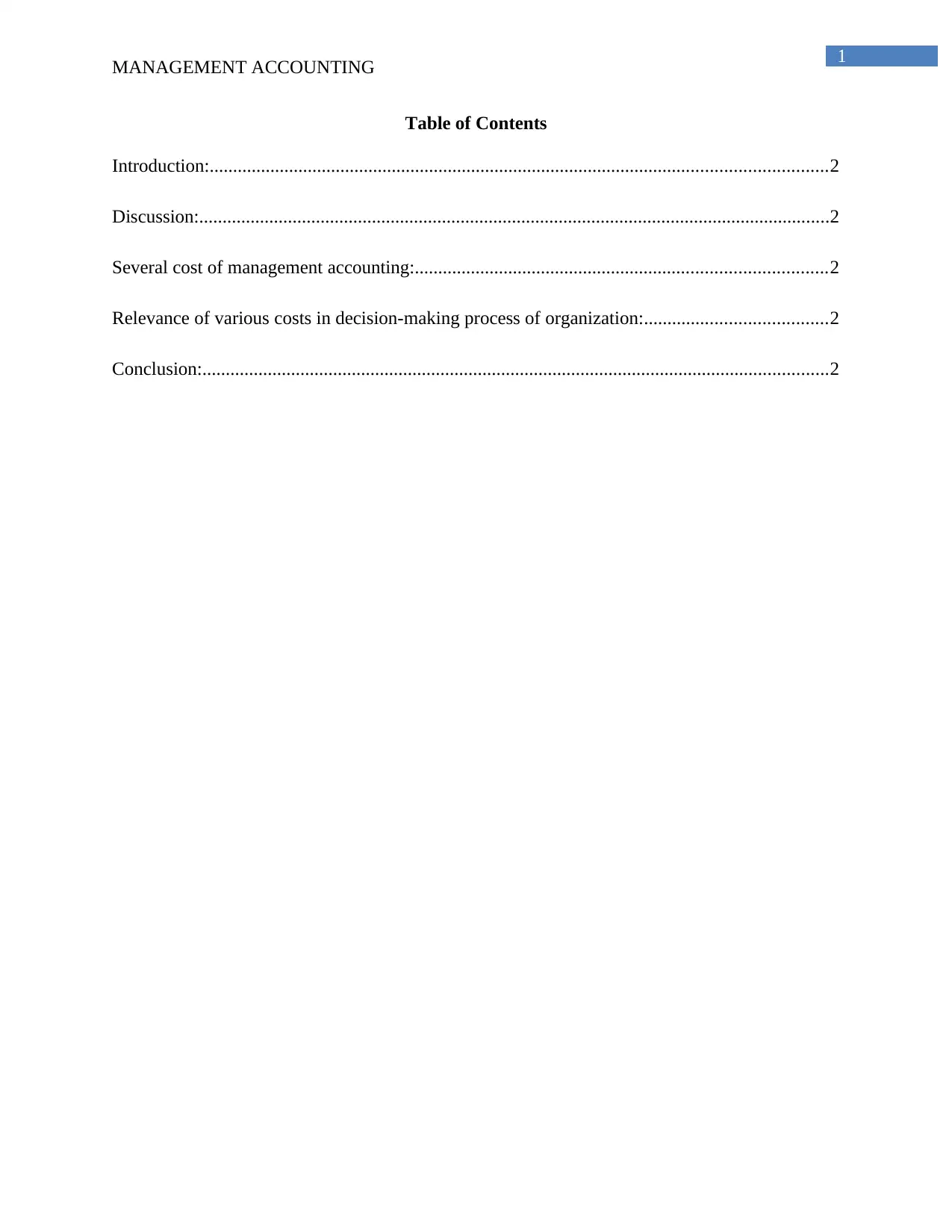
1
MANAGEMENT ACCOUNTING
Table of Contents
Introduction:....................................................................................................................................2
Discussion:.......................................................................................................................................2
Several cost of management accounting:........................................................................................2
Relevance of various costs in decision-making process of organization:.......................................2
Conclusion:......................................................................................................................................2
MANAGEMENT ACCOUNTING
Table of Contents
Introduction:....................................................................................................................................2
Discussion:.......................................................................................................................................2
Several cost of management accounting:........................................................................................2
Relevance of various costs in decision-making process of organization:.......................................2
Conclusion:......................................................................................................................................2
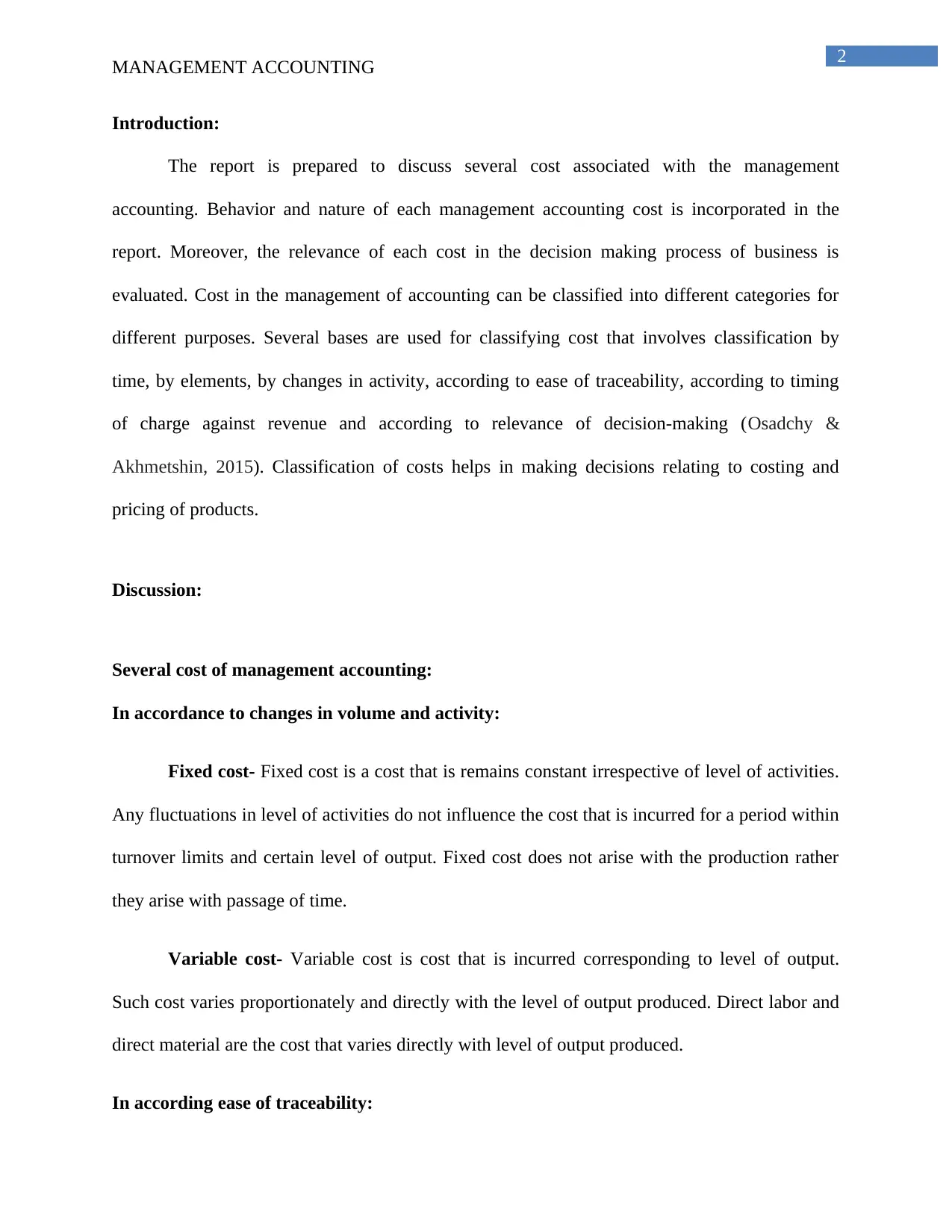
2
MANAGEMENT ACCOUNTING
Introduction:
The report is prepared to discuss several cost associated with the management
accounting. Behavior and nature of each management accounting cost is incorporated in the
report. Moreover, the relevance of each cost in the decision making process of business is
evaluated. Cost in the management of accounting can be classified into different categories for
different purposes. Several bases are used for classifying cost that involves classification by
time, by elements, by changes in activity, according to ease of traceability, according to timing
of charge against revenue and according to relevance of decision-making (Osadchy &
Akhmetshin, 2015). Classification of costs helps in making decisions relating to costing and
pricing of products.
Discussion:
Several cost of management accounting:
In accordance to changes in volume and activity:
Fixed cost- Fixed cost is a cost that is remains constant irrespective of level of activities.
Any fluctuations in level of activities do not influence the cost that is incurred for a period within
turnover limits and certain level of output. Fixed cost does not arise with the production rather
they arise with passage of time.
Variable cost- Variable cost is cost that is incurred corresponding to level of output.
Such cost varies proportionately and directly with the level of output produced. Direct labor and
direct material are the cost that varies directly with level of output produced.
In according ease of traceability:
MANAGEMENT ACCOUNTING
Introduction:
The report is prepared to discuss several cost associated with the management
accounting. Behavior and nature of each management accounting cost is incorporated in the
report. Moreover, the relevance of each cost in the decision making process of business is
evaluated. Cost in the management of accounting can be classified into different categories for
different purposes. Several bases are used for classifying cost that involves classification by
time, by elements, by changes in activity, according to ease of traceability, according to timing
of charge against revenue and according to relevance of decision-making (Osadchy &
Akhmetshin, 2015). Classification of costs helps in making decisions relating to costing and
pricing of products.
Discussion:
Several cost of management accounting:
In accordance to changes in volume and activity:
Fixed cost- Fixed cost is a cost that is remains constant irrespective of level of activities.
Any fluctuations in level of activities do not influence the cost that is incurred for a period within
turnover limits and certain level of output. Fixed cost does not arise with the production rather
they arise with passage of time.
Variable cost- Variable cost is cost that is incurred corresponding to level of output.
Such cost varies proportionately and directly with the level of output produced. Direct labor and
direct material are the cost that varies directly with level of output produced.
In according ease of traceability:
⊘ This is a preview!⊘
Do you want full access?
Subscribe today to unlock all pages.

Trusted by 1+ million students worldwide
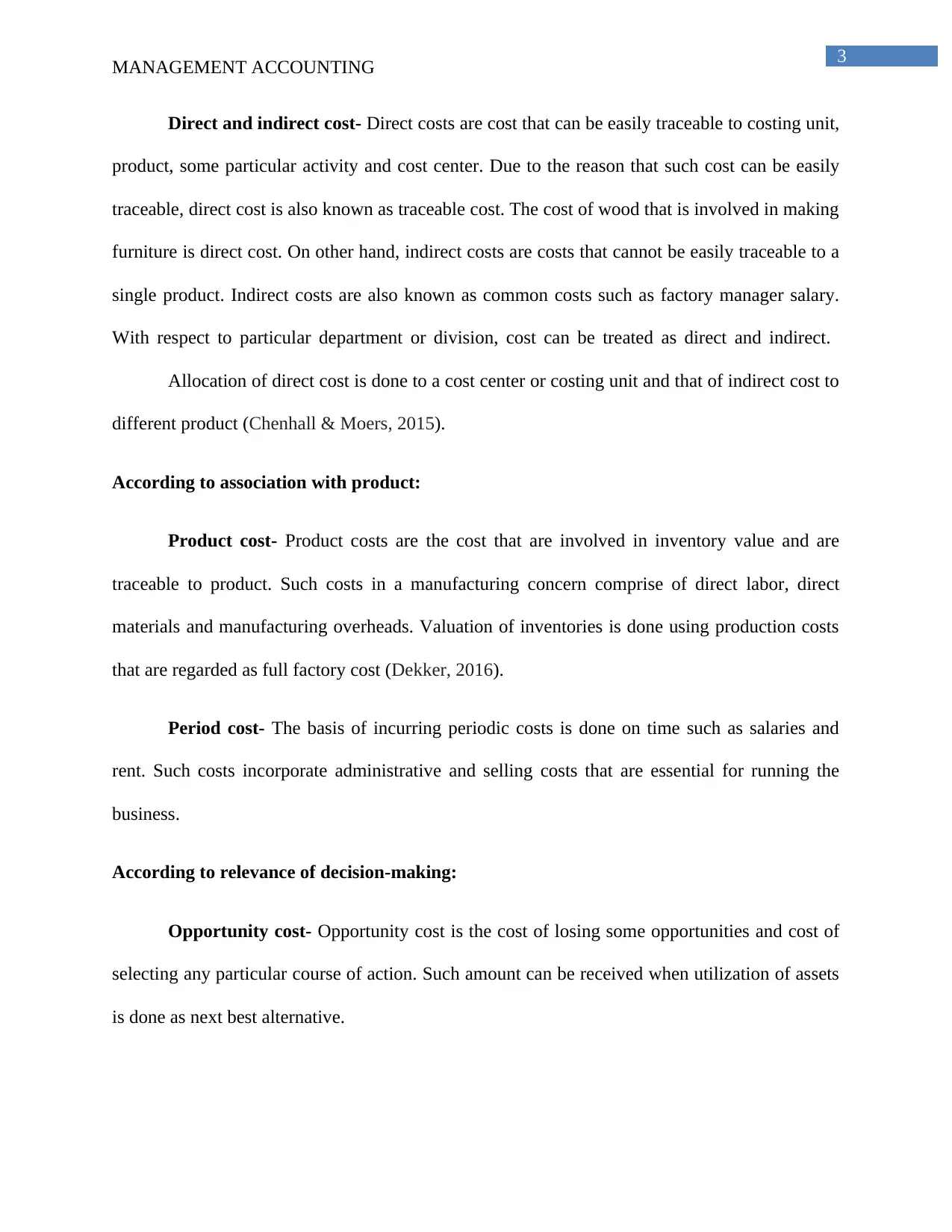
3
MANAGEMENT ACCOUNTING
Direct and indirect cost- Direct costs are cost that can be easily traceable to costing unit,
product, some particular activity and cost center. Due to the reason that such cost can be easily
traceable, direct cost is also known as traceable cost. The cost of wood that is involved in making
furniture is direct cost. On other hand, indirect costs are costs that cannot be easily traceable to a
single product. Indirect costs are also known as common costs such as factory manager salary.
With respect to particular department or division, cost can be treated as direct and indirect.
Allocation of direct cost is done to a cost center or costing unit and that of indirect cost to
different product (Chenhall & Moers, 2015).
According to association with product:
Product cost- Product costs are the cost that are involved in inventory value and are
traceable to product. Such costs in a manufacturing concern comprise of direct labor, direct
materials and manufacturing overheads. Valuation of inventories is done using production costs
that are regarded as full factory cost (Dekker, 2016).
Period cost- The basis of incurring periodic costs is done on time such as salaries and
rent. Such costs incorporate administrative and selling costs that are essential for running the
business.
According to relevance of decision-making:
Opportunity cost- Opportunity cost is the cost of losing some opportunities and cost of
selecting any particular course of action. Such amount can be received when utilization of assets
is done as next best alternative.
MANAGEMENT ACCOUNTING
Direct and indirect cost- Direct costs are cost that can be easily traceable to costing unit,
product, some particular activity and cost center. Due to the reason that such cost can be easily
traceable, direct cost is also known as traceable cost. The cost of wood that is involved in making
furniture is direct cost. On other hand, indirect costs are costs that cannot be easily traceable to a
single product. Indirect costs are also known as common costs such as factory manager salary.
With respect to particular department or division, cost can be treated as direct and indirect.
Allocation of direct cost is done to a cost center or costing unit and that of indirect cost to
different product (Chenhall & Moers, 2015).
According to association with product:
Product cost- Product costs are the cost that are involved in inventory value and are
traceable to product. Such costs in a manufacturing concern comprise of direct labor, direct
materials and manufacturing overheads. Valuation of inventories is done using production costs
that are regarded as full factory cost (Dekker, 2016).
Period cost- The basis of incurring periodic costs is done on time such as salaries and
rent. Such costs incorporate administrative and selling costs that are essential for running the
business.
According to relevance of decision-making:
Opportunity cost- Opportunity cost is the cost of losing some opportunities and cost of
selecting any particular course of action. Such amount can be received when utilization of assets
is done as next best alternative.
Paraphrase This Document
Need a fresh take? Get an instant paraphrase of this document with our AI Paraphraser
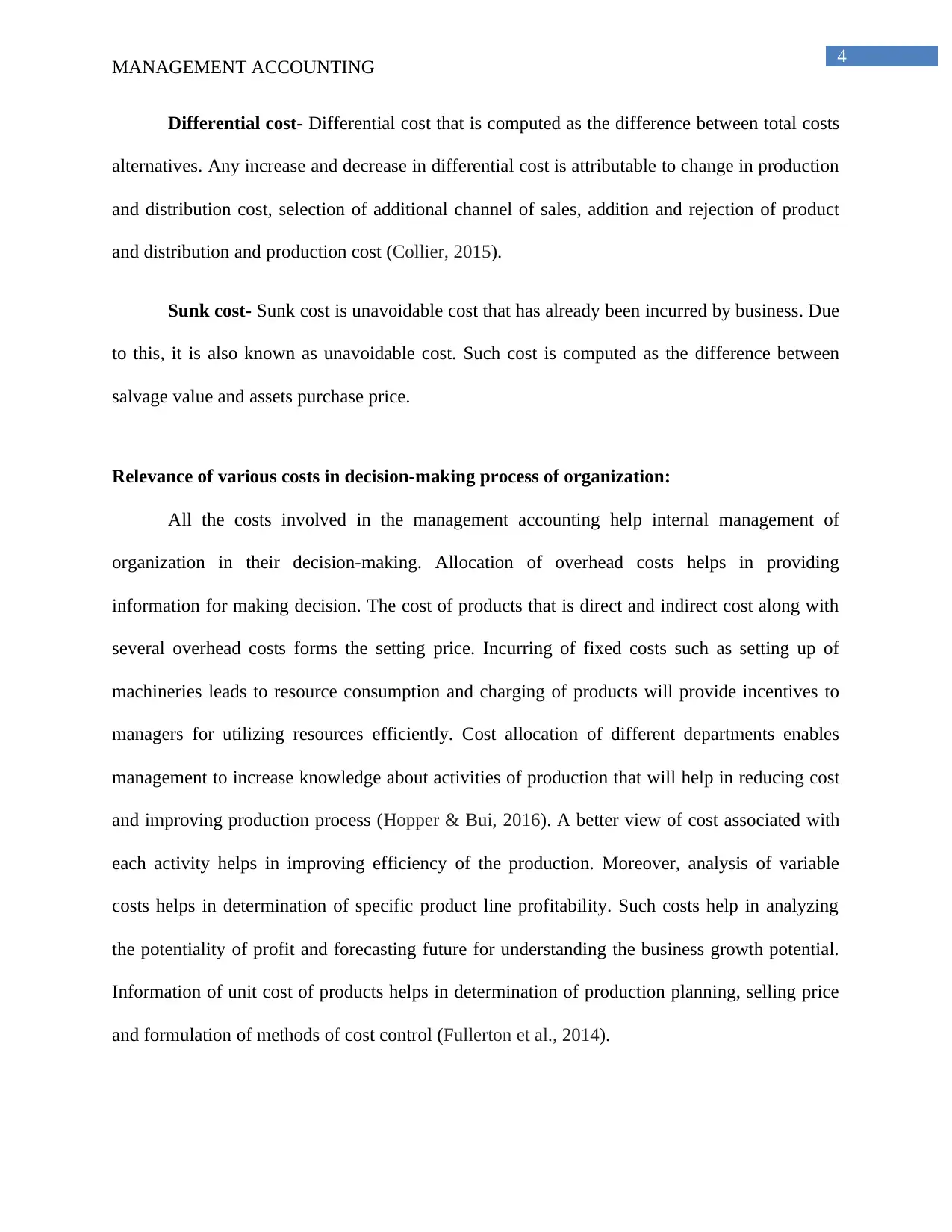
4
MANAGEMENT ACCOUNTING
Differential cost- Differential cost that is computed as the difference between total costs
alternatives. Any increase and decrease in differential cost is attributable to change in production
and distribution cost, selection of additional channel of sales, addition and rejection of product
and distribution and production cost (Collier, 2015).
Sunk cost- Sunk cost is unavoidable cost that has already been incurred by business. Due
to this, it is also known as unavoidable cost. Such cost is computed as the difference between
salvage value and assets purchase price.
Relevance of various costs in decision-making process of organization:
All the costs involved in the management accounting help internal management of
organization in their decision-making. Allocation of overhead costs helps in providing
information for making decision. The cost of products that is direct and indirect cost along with
several overhead costs forms the setting price. Incurring of fixed costs such as setting up of
machineries leads to resource consumption and charging of products will provide incentives to
managers for utilizing resources efficiently. Cost allocation of different departments enables
management to increase knowledge about activities of production that will help in reducing cost
and improving production process (Hopper & Bui, 2016). A better view of cost associated with
each activity helps in improving efficiency of the production. Moreover, analysis of variable
costs helps in determination of specific product line profitability. Such costs help in analyzing
the potentiality of profit and forecasting future for understanding the business growth potential.
Information of unit cost of products helps in determination of production planning, selling price
and formulation of methods of cost control (Fullerton et al., 2014).
MANAGEMENT ACCOUNTING
Differential cost- Differential cost that is computed as the difference between total costs
alternatives. Any increase and decrease in differential cost is attributable to change in production
and distribution cost, selection of additional channel of sales, addition and rejection of product
and distribution and production cost (Collier, 2015).
Sunk cost- Sunk cost is unavoidable cost that has already been incurred by business. Due
to this, it is also known as unavoidable cost. Such cost is computed as the difference between
salvage value and assets purchase price.
Relevance of various costs in decision-making process of organization:
All the costs involved in the management accounting help internal management of
organization in their decision-making. Allocation of overhead costs helps in providing
information for making decision. The cost of products that is direct and indirect cost along with
several overhead costs forms the setting price. Incurring of fixed costs such as setting up of
machineries leads to resource consumption and charging of products will provide incentives to
managers for utilizing resources efficiently. Cost allocation of different departments enables
management to increase knowledge about activities of production that will help in reducing cost
and improving production process (Hopper & Bui, 2016). A better view of cost associated with
each activity helps in improving efficiency of the production. Moreover, analysis of variable
costs helps in determination of specific product line profitability. Such costs help in analyzing
the potentiality of profit and forecasting future for understanding the business growth potential.
Information of unit cost of products helps in determination of production planning, selling price
and formulation of methods of cost control (Fullerton et al., 2014).
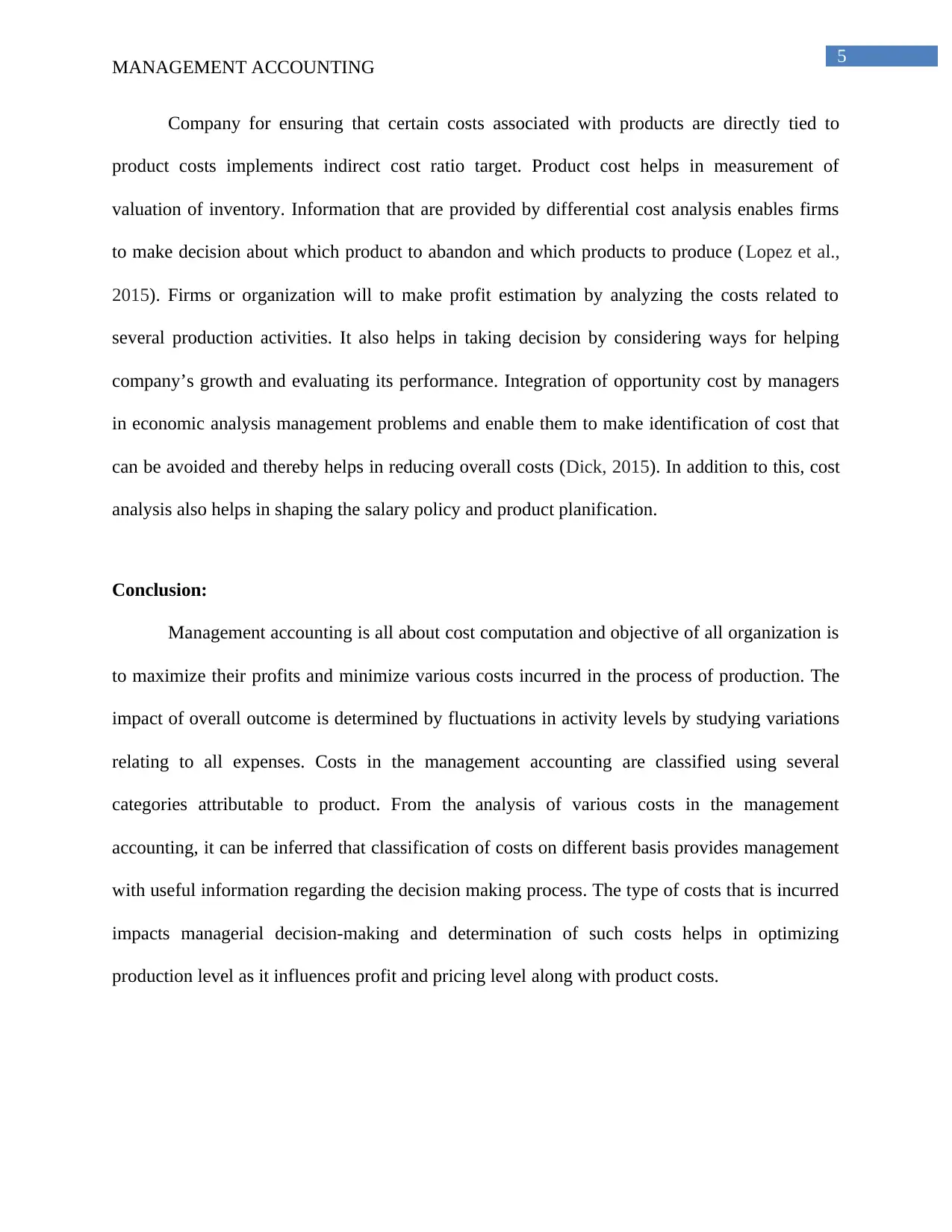
5
MANAGEMENT ACCOUNTING
Company for ensuring that certain costs associated with products are directly tied to
product costs implements indirect cost ratio target. Product cost helps in measurement of
valuation of inventory. Information that are provided by differential cost analysis enables firms
to make decision about which product to abandon and which products to produce (Lopez et al.,
2015). Firms or organization will to make profit estimation by analyzing the costs related to
several production activities. It also helps in taking decision by considering ways for helping
company’s growth and evaluating its performance. Integration of opportunity cost by managers
in economic analysis management problems and enable them to make identification of cost that
can be avoided and thereby helps in reducing overall costs (Dick, 2015). In addition to this, cost
analysis also helps in shaping the salary policy and product planification.
Conclusion:
Management accounting is all about cost computation and objective of all organization is
to maximize their profits and minimize various costs incurred in the process of production. The
impact of overall outcome is determined by fluctuations in activity levels by studying variations
relating to all expenses. Costs in the management accounting are classified using several
categories attributable to product. From the analysis of various costs in the management
accounting, it can be inferred that classification of costs on different basis provides management
with useful information regarding the decision making process. The type of costs that is incurred
impacts managerial decision-making and determination of such costs helps in optimizing
production level as it influences profit and pricing level along with product costs.
MANAGEMENT ACCOUNTING
Company for ensuring that certain costs associated with products are directly tied to
product costs implements indirect cost ratio target. Product cost helps in measurement of
valuation of inventory. Information that are provided by differential cost analysis enables firms
to make decision about which product to abandon and which products to produce (Lopez et al.,
2015). Firms or organization will to make profit estimation by analyzing the costs related to
several production activities. It also helps in taking decision by considering ways for helping
company’s growth and evaluating its performance. Integration of opportunity cost by managers
in economic analysis management problems and enable them to make identification of cost that
can be avoided and thereby helps in reducing overall costs (Dick, 2015). In addition to this, cost
analysis also helps in shaping the salary policy and product planification.
Conclusion:
Management accounting is all about cost computation and objective of all organization is
to maximize their profits and minimize various costs incurred in the process of production. The
impact of overall outcome is determined by fluctuations in activity levels by studying variations
relating to all expenses. Costs in the management accounting are classified using several
categories attributable to product. From the analysis of various costs in the management
accounting, it can be inferred that classification of costs on different basis provides management
with useful information regarding the decision making process. The type of costs that is incurred
impacts managerial decision-making and determination of such costs helps in optimizing
production level as it influences profit and pricing level along with product costs.
⊘ This is a preview!⊘
Do you want full access?
Subscribe today to unlock all pages.

Trusted by 1+ million students worldwide
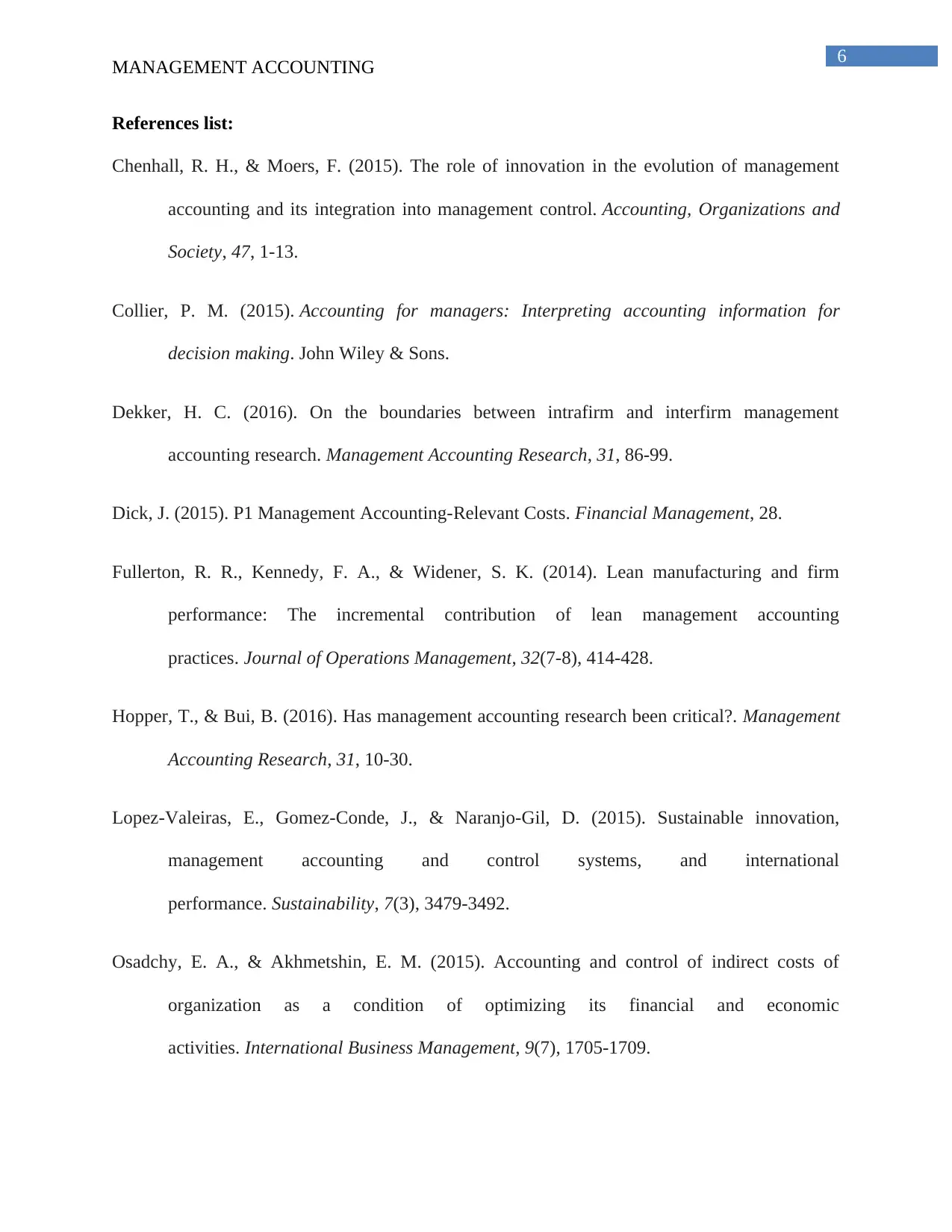
6
MANAGEMENT ACCOUNTING
References list:
Chenhall, R. H., & Moers, F. (2015). The role of innovation in the evolution of management
accounting and its integration into management control. Accounting, Organizations and
Society, 47, 1-13.
Collier, P. M. (2015). Accounting for managers: Interpreting accounting information for
decision making. John Wiley & Sons.
Dekker, H. C. (2016). On the boundaries between intrafirm and interfirm management
accounting research. Management Accounting Research, 31, 86-99.
Dick, J. (2015). P1 Management Accounting-Relevant Costs. Financial Management, 28.
Fullerton, R. R., Kennedy, F. A., & Widener, S. K. (2014). Lean manufacturing and firm
performance: The incremental contribution of lean management accounting
practices. Journal of Operations Management, 32(7-8), 414-428.
Hopper, T., & Bui, B. (2016). Has management accounting research been critical?. Management
Accounting Research, 31, 10-30.
Lopez-Valeiras, E., Gomez-Conde, J., & Naranjo-Gil, D. (2015). Sustainable innovation,
management accounting and control systems, and international
performance. Sustainability, 7(3), 3479-3492.
Osadchy, E. A., & Akhmetshin, E. M. (2015). Accounting and control of indirect costs of
organization as a condition of optimizing its financial and economic
activities. International Business Management, 9(7), 1705-1709.
MANAGEMENT ACCOUNTING
References list:
Chenhall, R. H., & Moers, F. (2015). The role of innovation in the evolution of management
accounting and its integration into management control. Accounting, Organizations and
Society, 47, 1-13.
Collier, P. M. (2015). Accounting for managers: Interpreting accounting information for
decision making. John Wiley & Sons.
Dekker, H. C. (2016). On the boundaries between intrafirm and interfirm management
accounting research. Management Accounting Research, 31, 86-99.
Dick, J. (2015). P1 Management Accounting-Relevant Costs. Financial Management, 28.
Fullerton, R. R., Kennedy, F. A., & Widener, S. K. (2014). Lean manufacturing and firm
performance: The incremental contribution of lean management accounting
practices. Journal of Operations Management, 32(7-8), 414-428.
Hopper, T., & Bui, B. (2016). Has management accounting research been critical?. Management
Accounting Research, 31, 10-30.
Lopez-Valeiras, E., Gomez-Conde, J., & Naranjo-Gil, D. (2015). Sustainable innovation,
management accounting and control systems, and international
performance. Sustainability, 7(3), 3479-3492.
Osadchy, E. A., & Akhmetshin, E. M. (2015). Accounting and control of indirect costs of
organization as a condition of optimizing its financial and economic
activities. International Business Management, 9(7), 1705-1709.
1 out of 7
Related Documents
Your All-in-One AI-Powered Toolkit for Academic Success.
+13062052269
info@desklib.com
Available 24*7 on WhatsApp / Email
![[object Object]](/_next/static/media/star-bottom.7253800d.svg)
Unlock your academic potential
Copyright © 2020–2025 A2Z Services. All Rights Reserved. Developed and managed by ZUCOL.




